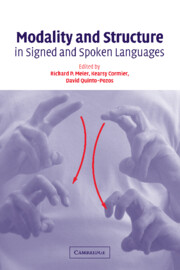Book contents
- Frontmatter
- Contents
- List of figures
- List of tables
- List of contributors
- Acknowledgements
- 1 Why different, why the same? Explaining effects and non-effects of modality upon linguistic structure in sign and speech
- Part I Phonological structure in signed languages
- Part II Gesture and iconicity in sign and speech
- 7 A modality-free notion of gesture and how it can help us with the morpheme vs. gesture question in sign language linguistics (Or at least give us some criteria to work with)
- 8 Gesture as the substrate in the process of ASL grammaticization
- 9 A crosslinguistic examination of the lexicons of four signed languages
- Part III Syntax in sign: Few or no effects of modality
- Part IV Using space and describing space: Pronouns, classifiers, and verb agreement
- Index
- References
7 - A modality-free notion of gesture and how it can help us with the morpheme vs. gesture question in sign language linguistics (Or at least give us some criteria to work with)
Published online by Cambridge University Press: 22 September 2009
- Frontmatter
- Contents
- List of figures
- List of tables
- List of contributors
- Acknowledgements
- 1 Why different, why the same? Explaining effects and non-effects of modality upon linguistic structure in sign and speech
- Part I Phonological structure in signed languages
- Part II Gesture and iconicity in sign and speech
- 7 A modality-free notion of gesture and how it can help us with the morpheme vs. gesture question in sign language linguistics (Or at least give us some criteria to work with)
- 8 Gesture as the substrate in the process of ASL grammaticization
- 9 A crosslinguistic examination of the lexicons of four signed languages
- Part III Syntax in sign: Few or no effects of modality
- Part IV Using space and describing space: Pronouns, classifiers, and verb agreement
- Index
- References
Summary
Liddell's proposal that there are gestures in agreement verbs
Forty years of research on signed languages has revealed the unquestionable fact that signers construct their utterances in a structured way from units that are defined within a language system. They do not pantomime or “draw pictures in the air.” But does this mean that every aspect of a signed articulation should have the same status as a linguistic unit?
A proposal by Liddell (1995; 1996; Liddell and Metzger 1998) has brought the issue of the linguistic status of certain parts of American Sign Language (ASL) utterances to the fore. He proposes that agreement verbs are not verbs simultaneously articulated with agreement morphemes, but verbs simultaneously articulated with pointing gestures. Agreement verbs are verbs that move to locations in signing space associated with particular referents in the discourse. A signer may establish a man on the left side at location x and a woman on the right side at location y. Then, to sign ‘He asks her,’ the signer moves the lexical sign ASK from location x to location y. The locations in these constructions have been analyzed as agreement morphemes (Fischer and Gough 1978; Klima and Bellugi 1979; Padden 1988; Liddell and Johnson 1989; Lillo-Martin and Klima 1990; Aarons et al. 1992) that combine with the lexical verb to form a multimorphemic sign x ASKy.
- Type
- Chapter
- Information
- Modality and Structure in Signed and Spoken Languages , pp. 175 - 198Publisher: Cambridge University PressPrint publication year: 2002
References
- 45
- Cited by



